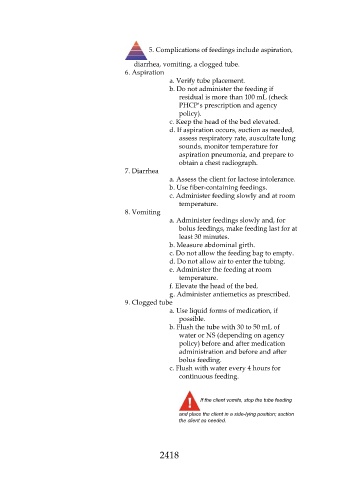Page 2418 - Saunders Comprehensive Review For NCLEX-RN
P. 2418
5. Complications of feedings include aspiration,
diarrhea, vomiting, a clogged tube.
6. Aspiration
a. Verify tube placement.
b. Do not administer the feeding if
residual is more than 100 mL (check
PHCP’s prescription and agency
policy).
c. Keep the head of the bed elevated.
d. If aspiration occurs, suction as needed,
assess respiratory rate, auscultate lung
sounds, monitor temperature for
aspiration pneumonia, and prepare to
obtain a chest radiograph.
7. Diarrhea
a. Assess the client for lactose intolerance.
b. Use fiber-containing feedings.
c. Administer feeding slowly and at room
temperature.
8. Vomiting
a. Administer feedings slowly and, for
bolus feedings, make feeding last for at
least 30 minutes.
b. Measure abdominal girth.
c. Do not allow the feeding bag to empty.
d. Do not allow air to enter the tubing.
e. Administer the feeding at room
temperature.
f. Elevate the head of the bed.
g. Administer antiemetics as prescribed.
9. Clogged tube
a. Use liquid forms of medication, if
possible.
b. Flush the tube with 30 to 50 mL of
water or NS (depending on agency
policy) before and after medication
administration and before and after
bolus feeding.
c. Flush with water every 4 hours for
continuous feeding.
If the client vomits, stop the tube feeding
and place the client in a side-lying position; suction
the client as needed.
2418

